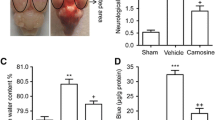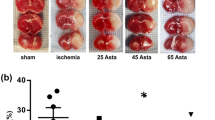Abstract
The present study was aimed to study the neuroprotective therapeutic effect of curcumin on the male albino rat brain. Subarachnoid hemorrhage leads to severe mortality rate and morbidity, and oxidative stress is a crucial factor in subarachnoid hemorrhage. Therefore, we investigated the effect of curcumin on oxidative stress and glutamate and glutamate transporter-1 on a subarachnoid hemorrhage-induced male albino rats. The curcumin commonly used for the treatment and saline used for the control. Curcumin (10 mg/kg bwt) dissolved in saline and administered orally to the rats for one week. Glutamate, glutamate transporter-1, malondialdehyde (MDA), superoxide dismutase (SOD), catalase, glutathione reductase and lactate dehydrogenase (LDH) activities were determined. Glutamate level was lower in the curcumin-treated rats compared to their respective controls. Glutamate transporter-1 did not alter in the curcumin-treated rats compared to their controls. Glutamate transporter-1 protein expression is significantly reduced in the curcumin-treated rats. MDA levels decreased 18 and 29 % in the hippocampus and the cortex region respectively. SOD (17% and 32%), and catalase (19% and 24%) activities were increased in the curcumin-treated hippocampus and the cortex region respectively. Glutathione reductase (13% and 19%) and LDH (21% and 30%) activities were increased in the treated hippocampus and the cortex region respectively. The mRNA expression of NK-kB and TLR4 was significantly reduced following curcumin treatment. Taking all these data together, the curcumin found to be effective against oxidative stress and glutamate neurotoxicity in the male albino rats.










Similar content being viewed by others
References
Manolova Y, Deneva V, Antonov L, Momekova D, Lambov N. The effect of the water on the curcumin tautomerism: A quantitative approach. Spectrochimica Acta 2014;132A (1): 815–820.
Dutta S, Padhye S, Priyadarsini KI, Newton C. Antioxidant and antiproliferative activity of curcumin semicarbazone. Bioorg Med Chem Lett 2005;15:2738–44.
Weber WM, Hunsaker LA, Abcouwer SF, Deck LM, Vander Jagt DL. Anti-oxidant activities of curcumin and related enones. Bioorg Med Chem. 2005;13:3811–20.
Lim CS, Jin DQ, Mok H, Oh SJ, Lee JU, Hwang JK, Ha I, Han JS. Antioxidant and anti-inflammatory activities of xanthorrhizol in hippocampal neurons and primary cultured microglia. J Neurosci Res 2005;82:831–8.
Biswas SK, McClure D, Jimenez LA, Megson IL, Rahman I. Curcumin induces glutathione biosynthesis and inhibits NF-kappaB activation and interleukin-8 release in alveolar epithelial cells: Mechanism of free radical scavenging activity. Antioxid Redox Signal 2005;7:32–41.
Kala C, Ali Syed S, Abid M, Rajpoot S, Khan NA. Protection Against FCA Induced Oxidative Stress Induced DNA Damage in a Model of Arthritis and In vitro Antiarthritic Potential of Costus species Rhizome Extract.www.ijppr.com International Journal of Pharmacognosy and Phytochemical Research 2015;7(2): 383–389.
Lauderback CM, Hackett JM, Huang FF, Keller JN, Szweda LI, Markesbery WR, Butterfield DA. The glial glutamate transporter,GLT-1, is oxidatively modified by 4-hydroxy-2-nonenal in the Alzheimer’s disease brain: The role of Abeta1-42. J Neurochem 2001;78:413–6.
Suarez JI, Tarr RW, Selman WR. Aneurysmal subarachnoid hemorrhage. N Engl J Med 2006;354:387–96.
Wakade C, King MD, Laird MD, Alleyne CH, Jr., Dhandapani KM. Curcumin attenuates vascular inflammation and cerebral vasospasm after subarachnoid hemorrhage in mice. Antioxid Redox Signal 2009;11:35–45.
Aladag MA, Turkoz Y, Ozcan C, Sahna E, Parlakpinar H, Akpolat N, Cigremis Y. Caffeic acid phenethyl ester (CAPE) attenuates cerebral vasospasm after experimental subarachnoidal haemorrhage by increasing brain nitric oxide levels. Int J Dev Neurosci 2006;24:9–14.
Nishizawa Y. Glutamate release and neuronal damage in ischemia. Life Sci 2001;69:369–81.
Anderson CM, Swanson RA. Astrocyte glutamate transport: Review of properties, regulation, and physiological functions. Glia 32:1–14.
Lee SG, Su ZZ, Emdad L, Gupta P, Sarkar D, Borjabad A, Volsky DJ, Fisher PB. Mechanism of ceftriaxone induction of excitatory amino acid transporter-2 expression and glutamate uptake in primary human astrocytes. J Biol Chem 2008;283:13116–23.
Hu Y, Mitchell KM, Albahadily FN, Michaelis EK, Wilson GS. Direct measurement of glutamate release in the brain using a dual enzyme-based electrochemical sensor. Brain Res 1994;659:117–25.
Muthuraman P, Jeongeun P, Eunjung K. Aspartame downregulates 3T3-L1 differentiation. In Vitro Cellular & Developmental Biology-Animal 2014;50(9): 851–857.
Muthuraman P, Ramkumar K, Kim DH. Analysis of dose-dependent effect of zinc oxide nanoparticles on the oxidative stress and antioxidant enzyme activity in adipocytes. Applied Biochemistry and Biotechnology 2014;174 (8): 2851–2863.
Weydert CJ, Cullen JJ. Measurement of superoxide dismutase, catalase and glutathione peroxidase in cultured cells and tissue Nature Protocols 2009;5:51–66.
Dawei AI, Zhisheng W, Anguo Z. World Journal of Agricultural Sciences 2010;6:149–153.
Muthuraman P. Effect of cortisol on caspases in the co-cultured C2C12 and 3T3-L1 cells. Applied Biochemistry and Biotechnology 2014;173 (4): 980–988.
Choi DW. Ischemia-induced neuronal apoptosis. Curr Opin Neurobiol 1996;6:667–72.
German A, Caffo M, Angileri FF, Arcadi F, Newcomb-Fernandez J, Caruso G, Meli F, Pineda JA, Lewis SB, Wang KK, Bramanti P, Costa C, Hayes RL. NMDA receptor antagonist felbamate reduces behavioral deficits and blood-brain barrier permeability changes after experimental subarachnoid hemorrhage in the rat. J Neurotrauma 2007;24:732–44.
Wu CT, Wen LL, Wong CS, Tsai SY, Chan SM, Yeh CC, Borel CO, Cherng CH. Temporal changes in glutamate, glutamate transporters, basilar arteries wall thickness, and neuronal variability in an experimental rat model of subarachnoid hemorrhage. Anesth Analg 2011;112:666–73.
Berti V, Murray J, Davies M, Spector N, Tsui WH, Li Y, Williams S, Pirraglia E, Vallabhajosula S, McHugh P, Pupi A, de Leon MJ, Mosconi L. Nutrient patterns and brain biomarkers of Alzheimer’s disease in cognitively normal individuals. J Nutr Health Aging 2015;19(4): 413–23.
Yang YH, Hsieh TJ, Tsai ML, Chen CH, Lin HT, Wu SJ. Neuroprotective effects of Hu-Yi-Neng, a diet supplement, on SH-SY5Y human neuroblastoma cells. J Nutr Health Aging 2014;18(2):184–90.
Suh HW, Kang S, Kwon KS. Curcumin attenuates glutamate-induced HT22 cell death by suppressing MAP kinase signaling. Mol Cell Biochem 2007;298:187–94.
Lee SG, Su ZZ, Emdad L, Gupta P, Sarkar D, Borjabad A, Volsky DJ, Fisher PB. Mechanism of ceftriaxone induction of excitatory amino acid transporter-2 expression and glutamate uptake in primary human astrocytes. J Biol Chem 2008;283:13116–23.
Lpez-Redondo F, Nakajima K, Honda S, Kohsaka S. Glutamate transporter GLT-1 is highly expressed in activated microglia following facial nerve axotomy. Brain Res Mol Brain Res 2000;76:429–35.
Ouyang YB, Voloboueva LA, Xu LJ, Giffard RG. Selective dysfunction of hippocampal CA1 astrocytes contributes to delayed neuronal damage after transient forebrain ischemia. J Neurosci 2007;27:4253–60.
Lauderback CM, Hackett JM, Huang FF, Keller JN, Szweda LI, Markesbery WR, Butterfield DA. The glial glutamate transporter, GLT-1, is oxidatively modified by 4-hydroxy-2-nonenal in the Alzheimer’s disease brain: The role of Abeta1-42. J Neurochem 2001;78:413–6
Author information
Authors and Affiliations
Corresponding author
Additional information
These two authors contributed equally to this article.
Rights and permissions
About this article
Cite this article
Zhang, L., Kong, XJ., Wang, ZQ. et al. A study on neuroprotective effects of curcumin on the diabetic rat brain. J Nutr Health Aging 20, 835–840 (2016). https://doi.org/10.1007/s12603-016-0723-0
Received:
Accepted:
Published:
Issue Date:
DOI: https://doi.org/10.1007/s12603-016-0723-0




